
Researchers of the Universitat de València in collaboration with other centres have collected in a single document all the information that is known on the lack of alfa-1 Antitrypsin Deficiency (DAAT). It is a strange disease that is underdiagnosed and, according to epidemiologists, affects about 120,000 people in Europe.
The disease consists in a lack of alfa-1 Antitrypsin, which is produced in the liver. The main objective of this protein is protecting the lungs from deterioration or inflammation caused by infections that attack the tissue of the lung, tobacco or pollution. Alfa-1 Antitrypsin goes from the liver to the lungs through the blood. However, if this transfer is not conducted properly, the accumulation can cause hepatic diseases like lung problems such as emphysema. According to the study, this disease is underdiagnosed to an extent that 90% of the affected people don’t know that they have it.
The article aimed to help researchers and medical specialists to understand better the disorder in order to make research easier, avoid mistaken diagnosis and increase the efficiency of the treatment. The Department of Paediatrics, Obstetrics, Gynaecology and Physiology of the Universitat de València; the Health Institute Carlos III de Madrid, the Hospital Vall de Hebrón or the Institute of Health Research INCLIVA have taken part in the researching process.
This article includes a specific chapter addressing the disease during the pediatric age group. It also updates the last researches on epigenetics, biomarkers or the future therapeutic strategies, including genetic engineering research.
In addition, the study has highlighted the clinical efficiency of the replacement therapy. It had been questioned in several countries due to the reduced number of clinical trials that have been conducted. This is the reason why national health agencies don’t want to pay for the treatments. Therefore, patients must pay finance their medication.
One of the main problems of the treatment is the clinical variability of the patients. Some patients don’t show any symptoms while others develop them in their childhood, puberty or being young adult. According to the research team, this is the reason why biomarkers that can predict the development of the disease and the treatment are needed. This fact will increase the comprehension of the molecular mechanisms involved.
Article:
Torres-Durán et al. «Alpha-1 antitrypsin deficiency: outstanding questions and future directions ». Orphanet Journal of Rare Diseases (2018) 13:114
https://doi.org/10.1186/s13023-018-0856-9
Caption:
The research team that has participated in the revision of the alfa-1 Antitrypsin Deficiency (DAAT).
Images:











